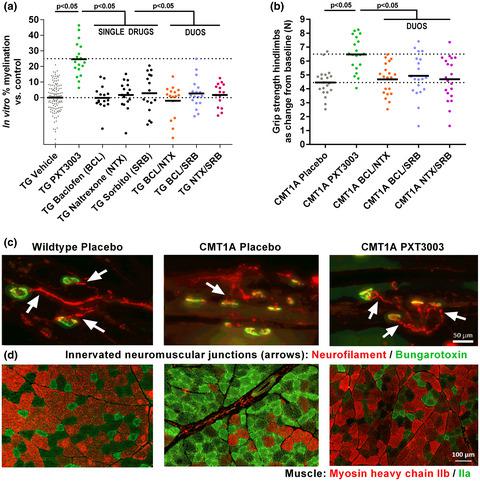当前位置:
X-MOL 学术
›
J. Neurosci. Res.
›
论文详情
Our official English website, www.x-mol.net, welcomes your
feedback! (Note: you will need to create a separate account there.)
Synergistic PXT3003 therapy uncouples neuromuscular function from dysmyelination in male Charcot-Marie-Tooth disease type 1A (CMT1A) rats.
Journal of Neuroscience Research ( IF 2.9 ) Pub Date : 2020-06-26 , DOI: 10.1002/jnr.24679 Thomas Prukop 1, 2 , Stephanie Wernick 1, 3 , Lydie Boussicault 4 , David Ewers 1, 3 , Karoline Jäger 5 , Julia Adam 1 , Lorenz Winter 1 , Susanne Quintes 1, 3 , Lisa Linhoff 1, 3 , Alonso Barrantes-Freer 6 , Michael Bartl 3 , Dirk Czesnik 3 , Jana Zschüntzsch 5 , Jens Schmidt 5 , Gwenaël Primas 4 , Julien Laffaire 4 , Philippe Rinaudo 4 , Anthony Brureau 4 , Serguei Nabirotchkin 4 , Markus H Schwab 1 , Klaus-Armin Nave 1 , Rodolphe Hajj 4 , Daniel Cohen 4 , Michael W Sereda 1, 3
Journal of Neuroscience Research ( IF 2.9 ) Pub Date : 2020-06-26 , DOI: 10.1002/jnr.24679 Thomas Prukop 1, 2 , Stephanie Wernick 1, 3 , Lydie Boussicault 4 , David Ewers 1, 3 , Karoline Jäger 5 , Julia Adam 1 , Lorenz Winter 1 , Susanne Quintes 1, 3 , Lisa Linhoff 1, 3 , Alonso Barrantes-Freer 6 , Michael Bartl 3 , Dirk Czesnik 3 , Jana Zschüntzsch 5 , Jens Schmidt 5 , Gwenaël Primas 4 , Julien Laffaire 4 , Philippe Rinaudo 4 , Anthony Brureau 4 , Serguei Nabirotchkin 4 , Markus H Schwab 1 , Klaus-Armin Nave 1 , Rodolphe Hajj 4 , Daniel Cohen 4 , Michael W Sereda 1, 3
Affiliation

|
Charcot–Marie–Tooth disease 1 A (CMT1A) is caused by an intrachromosomal duplication of the gene encoding for PMP22 leading to peripheral nerve dysmyelination, axonal loss, and progressive muscle weakness. No therapy is available. PXT3003 is a low‐dose combination of baclofen, naltrexone, and sorbitol which has been shown to improve disease symptoms in Pmp22 transgenic rats, a bona fide model of CMT1A disease. However, the superiority of PXT3003 over its single components or dual combinations have not been tested. Here, we show that in a dorsal root ganglion (DRG) co‐culture system derived from transgenic rats, PXT3003 induced myelination when compared to its single and dual components. Applying a clinically relevant (“translational”) study design in adult male CMT1A rats for 3 months, PXT3003, but not its dual components, resulted in improved performance in behavioral motor and sensory endpoints when compared to placebo. Unexpectedly, we observed only a marginally increased number of myelinated axons in nerves from PXT3003‐treated CMT1A rats. However, in electrophysiology, motor latencies correlated with increased grip strength indicating a possible effect of PXT3003 on neuromuscular junctions (NMJs) and muscle fiber pathology. Indeed, PXT3003‐treated CMT1A rats displayed an increased perimeter of individual NMJs and a larger number of functional NMJs. Moreover, muscles of PXT3003 CMT1A rats displayed less neurogenic atrophy and a shift toward fast contracting muscle fibers. We suggest that ameliorated motor function in PXT3003‐treated CMT1A rats result from restored NMJ function and muscle innervation, independent from myelination.
中文翻译:

协同 PXT3003 治疗使雄性 Charcot-Marie-Tooth 病 1A 型 (CMT1A) 大鼠的神经肌肉功能与髓鞘形成障碍分离。
Charcot-Marie-Tooth 病 1A (CMT1A) 是由PMP22编码基因的染色体内重复引起的,导致周围神经髓鞘形成障碍、轴突缺失和进行性肌肉无力。没有治疗可用。PXT3003 是巴氯芬、纳曲酮和山梨糖醇的低剂量组合,已被证明可改善Pmp22 的疾病症状转基因大鼠,CMT1A 疾病的真实模型。然而,PXT3003 相对于其单一组件或双组合的优越性尚未经过测试。在这里,我们表明,在源自转基因大鼠的背根神经节 (DRG) 共培养系统中,与其单组分和双组分相比,PXT3003 可诱导髓鞘形成。与安慰剂相比,在成年雄性 CMT1A 大鼠中应用临床相关(“转化”)研究设计 3 个月,PXT3003,但不是其双组分,导致行为运动和感觉终点的性能提高。出乎意料的是,我们仅观察到 PXT3003 治疗的 CMT1A 大鼠神经中有髓轴突数量略有增加。然而,在电生理学中,运动潜伏期与增加的握力相关,表明 PXT3003 可能对神经肌肉接头 (NMJ) 和肌纤维病理学产生影响。事实上,PXT3003 治疗的 CMT1A 大鼠表现出单个 NMJ 的周长增加和更多的功能性 NMJ。此外,PXT3003 CMT1A 大鼠的肌肉表现出较少的神经源性萎缩和向快速收缩的肌肉纤维转变。我们建议 PXT3003 治疗的 CMT1A 大鼠运动功能的改善是由于 NMJ 功能和肌肉神经支配的恢复,与髓鞘形成无关。
更新日期:2020-06-26
中文翻译:

协同 PXT3003 治疗使雄性 Charcot-Marie-Tooth 病 1A 型 (CMT1A) 大鼠的神经肌肉功能与髓鞘形成障碍分离。
Charcot-Marie-Tooth 病 1A (CMT1A) 是由PMP22编码基因的染色体内重复引起的,导致周围神经髓鞘形成障碍、轴突缺失和进行性肌肉无力。没有治疗可用。PXT3003 是巴氯芬、纳曲酮和山梨糖醇的低剂量组合,已被证明可改善Pmp22 的疾病症状转基因大鼠,CMT1A 疾病的真实模型。然而,PXT3003 相对于其单一组件或双组合的优越性尚未经过测试。在这里,我们表明,在源自转基因大鼠的背根神经节 (DRG) 共培养系统中,与其单组分和双组分相比,PXT3003 可诱导髓鞘形成。与安慰剂相比,在成年雄性 CMT1A 大鼠中应用临床相关(“转化”)研究设计 3 个月,PXT3003,但不是其双组分,导致行为运动和感觉终点的性能提高。出乎意料的是,我们仅观察到 PXT3003 治疗的 CMT1A 大鼠神经中有髓轴突数量略有增加。然而,在电生理学中,运动潜伏期与增加的握力相关,表明 PXT3003 可能对神经肌肉接头 (NMJ) 和肌纤维病理学产生影响。事实上,PXT3003 治疗的 CMT1A 大鼠表现出单个 NMJ 的周长增加和更多的功能性 NMJ。此外,PXT3003 CMT1A 大鼠的肌肉表现出较少的神经源性萎缩和向快速收缩的肌肉纤维转变。我们建议 PXT3003 治疗的 CMT1A 大鼠运动功能的改善是由于 NMJ 功能和肌肉神经支配的恢复,与髓鞘形成无关。











































 京公网安备 11010802027423号
京公网安备 11010802027423号